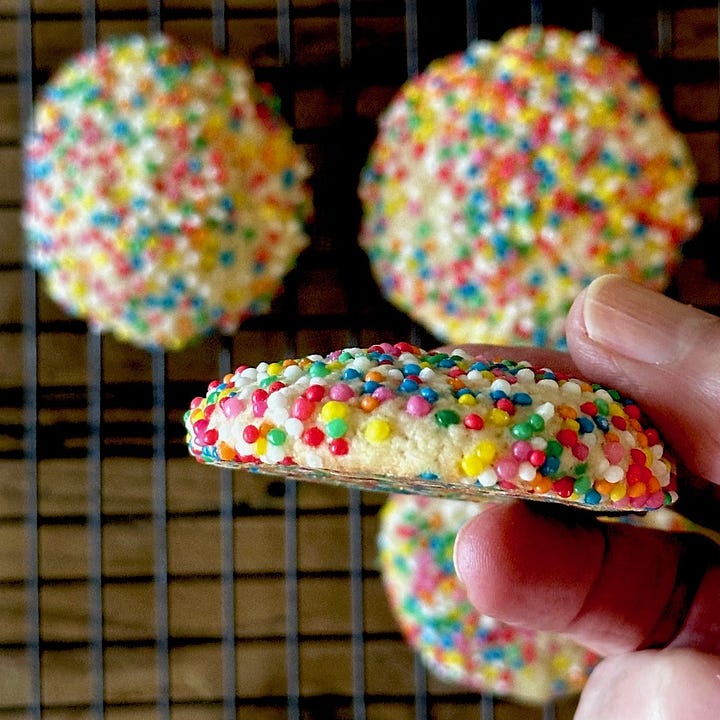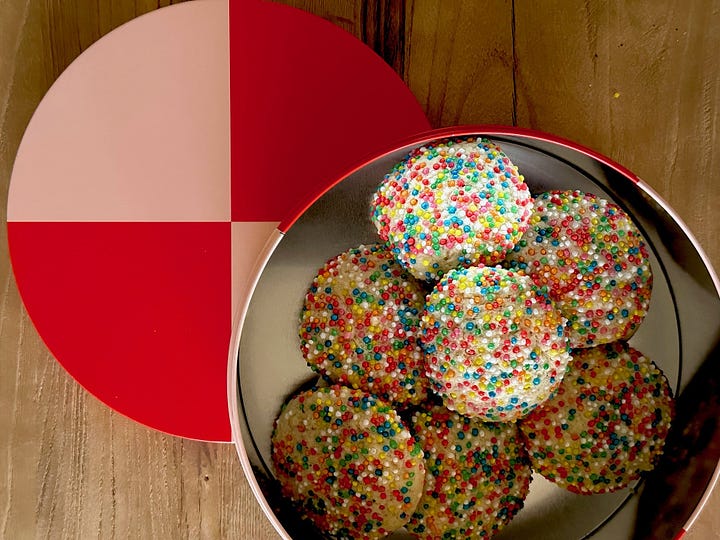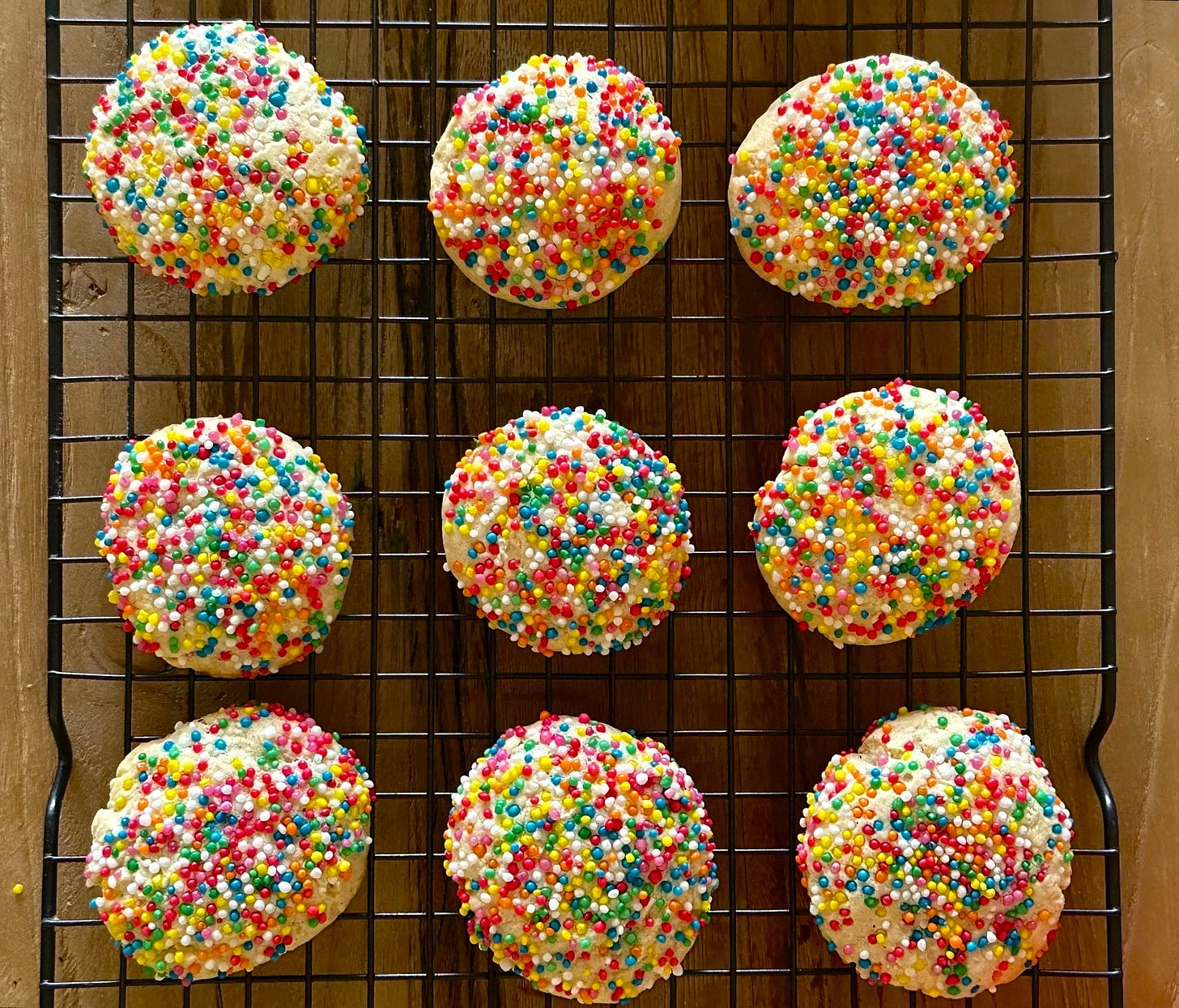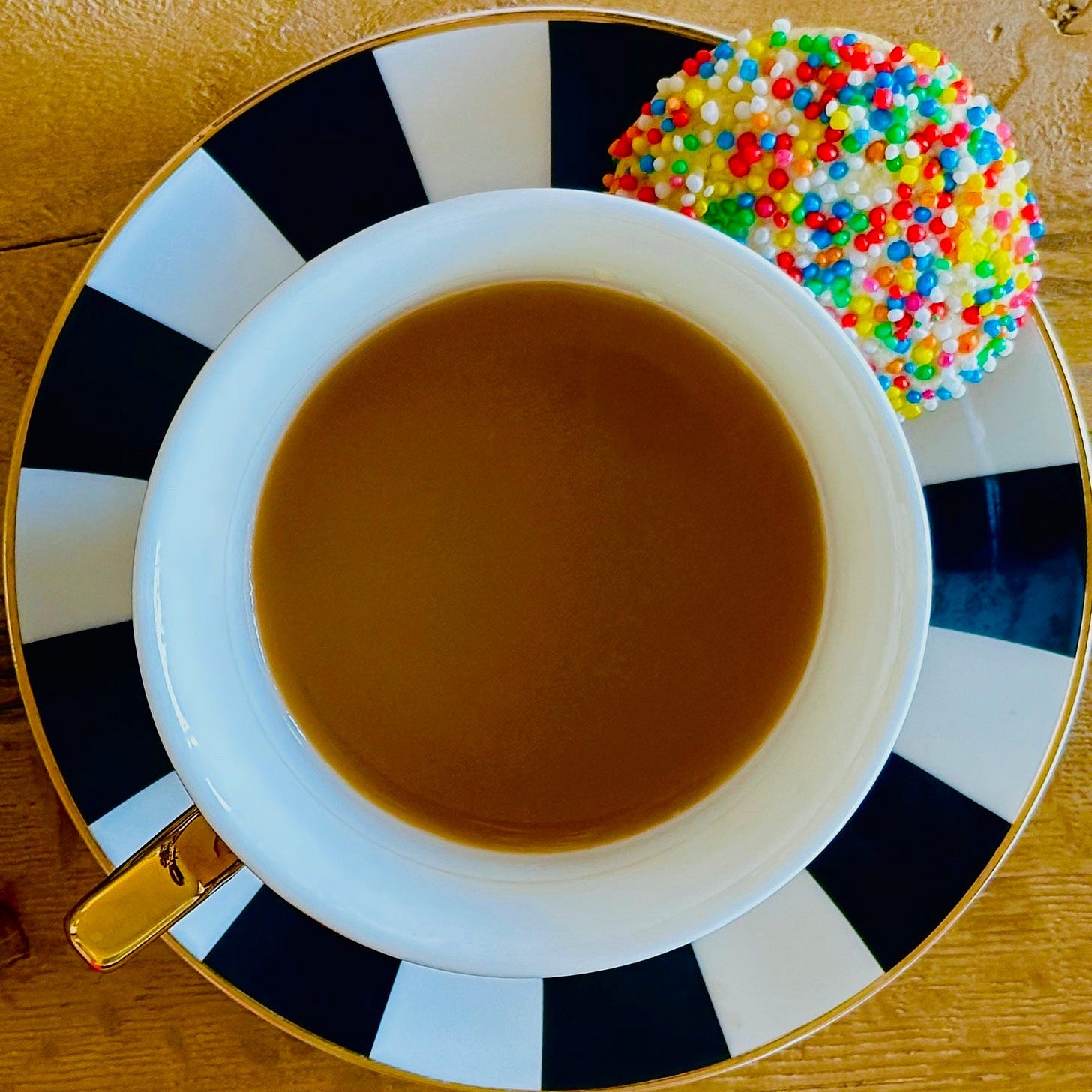If you can have fairy bread, my fellow Australians, then you can have fairy biscuits. It stands to reason.
This is my take on the Sprinkle cookies I saw ten years ago at Nate ’n Al’s Deli in Los Angeles. I was having a sensible bagel for breakfast instead, but I never forgot them.
Then they randomly popped into my brain and insisted on being recreated. I’ve learnt not to deny these inner requests, as they are only strengthened by rejection, and inevitably return in stronger form.
This is how we roll around here. We cave at the first opportunity.
Sprinkle biscuits have been around for almost as long as there have been sprinkles. The most likely origin story for sprinkles is that they began as ‘nonpareils’, tiny balls of sugar and starch used to decorate desserts and pastries in the eighteenth century.
The word ‘sprinkles’ probably comes from 1936, when Dutchman Gerard de Vries invented a machine that made long cylindrical chocolate sprinkles for a company called Venz. He called them ‘hagelslag’, meaning hailstorm strike, for the way in which they fell like rain onto bread. It’s not a great mental leap, then, to call them sprinkles. (Great name, though, hagelslag.)
So I borrowed my own recipe for another, non-sprinkle biscuit, rolled the dough into balls, coated them in sprinkles and pressed them to flatten (rather than rolling out the dough and cutting out perfect cookie-cutter rounds).
This is a lovely dough to handle, soft and smooth. And it bakes into what, to me, is close to the perfect biscuit: crisp outside, and soft and buttery inside.
FAIRY BISCUITS
100 g butter, softened
80 g caster sugar
1 medium egg, lightly beaten
1 tsp vanilla extract
Pinch of sea salt
200 g plain flour
half tsp baking powder
1 tsp mixed spice
100 g hundreds and thousands
Heat the oven to 180C (160C fan-forced).
Beat the butter and sugar with an electric mixer until pale and fluffy.
Beat in the egg, vanilla and salt until well-mixed.
Sift the flour, baking powder and mixed spice into the mixture in two lots, gradually bringing it together with a spatula until it comes together as one smooth dough.
Line two baking trays with baking paper, and place hundreds and thousands in a small bowl.
Take one dessert spoon of mixture (30g) and roll into a smooth ball in your hands.
Toss it in the hundreds and thousands until coated, and place on the baking tray.
Using the flat bottom of a glass, gently press down on it, to flatten it by half.
Repeat with remaining biscuits, leaving a little room for spreading.
Bake for 16 to 18 minutes until just-cooked, but not browned.
Use a spatula to transfer the biscuits to a wire rack, and leave to cool.


#If the dough is too soft to handle, wrap it in cling film and refrigerate for 30 minutes. Work quickly, especially if your kitchen is warm. If you’re baking one tray at a time, then refrigerate the remaining dough until you prepare the second tray’s worth.
# Some grated lemon zest is a rather nice addition to the biscuit dough.
# Don’t worry if the biscuits aren’t completely coated with sprinkles; we like a human element.*
# Pull them out when you can lift one up enough to see the bottom. Tap the bottom and if you hear the sound of the tap, they’re done – and will continue to firm up as they cool.
# If you think you have taken them out of the oven a bit early, then leave them on the hot baking tray for 5 minutes before removing to the wire rack.
# Store in an air-tight container for up to three days (probably more, but I’ve only just baked them myself, so I don’t know yet).
* The above statement is a lie. We humans actually love making things so perfectly that they look like a machine did the job. My view is that there are machines for making things look like machines did the job. We should praise and admire the human element, therefore, before the machines deem us imperfect and take over the biscuit-making. And everything else.
Thanks for dropping by! And thanks for your comments and suggestions. Special thanks to Terry for throwing himself whole-heartedly into the science and theory of sprinkles. He suggested engineering the biscuits so the sprinkles are just across the top, not underneath as well. So I tried a couple whereby I rolled the dough into balls, then pressed just one side of the ball into the sprinkles, placed it on the baking tray sprinkle-side up, and then pressed it down with the bottom of a glass, like the others. Annoyingly, this also worked very well.
Thanks also to my eagle-eyed subscriber Vicki, who noted a discrepancy in the original recipe sent out (it said “add egg yolk” instead of ‘add egg”). Now corrected, many thanks.
Thanks also to Nate ’n Al, opened in 1947; here’s a lovely pic from their website.
I would like to acknowledge the traditional owners of the lands and waters upon which I work, live, cook and play; the Gadigal people of the Eora Nation. Thank you for sharing your culture, traditions, knowledge, spirit, art, music, humour and food traditions, allowing us all to experience a greater sense of belonging in this ancient land.








Me and my new Granddaughter. One day 🩷
My family loved these! Great recipe thanks